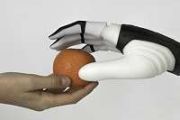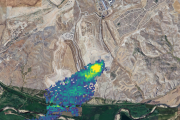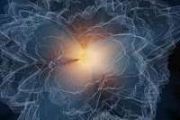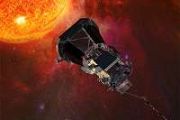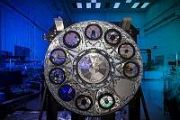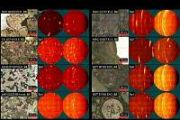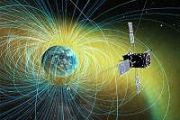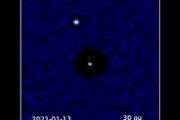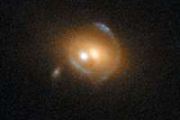
Copernical Team
Four astronauts leave space station for trip back to Earth
 After nearly five months onboard the International Space Station, an international crew of five astronauts began their descent back down to Earth on a SpaceX capsule Friday.
US astronauts Anne McClain and Nichole Ayers, Japan's Takuya Onishi and Russian cosmonaut Kirill Peskov are expected to spend more than 17 hours in the capsule before splashing down off California's coast at 1533 GMT on
After nearly five months onboard the International Space Station, an international crew of five astronauts began their descent back down to Earth on a SpaceX capsule Friday.
US astronauts Anne McClain and Nichole Ayers, Japan's Takuya Onishi and Russian cosmonaut Kirill Peskov are expected to spend more than 17 hours in the capsule before splashing down off California's coast at 1533 GMT on Crew-10 undocks from International Space Station
 Members of the Crew-10 on Friday night undocked from the International Space Station aboard the Dragon 9 spacecraft.
The undocking was scheduled for 6:05 p.m. EDT and it was confirmed at 6:30 p.m. The hatch was closed at 4:20 p.m.
Dragon then executed a series of departure burns as the spacecraft moved away from the ISS, which orbits the Earth approximately 250 miles away.
Members of the Crew-10 on Friday night undocked from the International Space Station aboard the Dragon 9 spacecraft.
The undocking was scheduled for 6:05 p.m. EDT and it was confirmed at 6:30 p.m. The hatch was closed at 4:20 p.m.
Dragon then executed a series of departure burns as the spacecraft moved away from the ISS, which orbits the Earth approximately 250 miles away. SpaceX Crew-10 return delayed due to weather at splashdown site
 SpaceX and NASA delayed the return of Crew-10 astronauts to Earth that was originally scheduled to begin on Thursday afternoon.
The Crew-10's Dragon capsule, Endurance, will undock at 6:05 p.m. EDT on Friday for a 17.5-hour journey and is scheduled to splash down in the Pacific Ocean off the coast of California at 11:33 a.m. Saturday.
The crew was initially set to begin its retur
SpaceX and NASA delayed the return of Crew-10 astronauts to Earth that was originally scheduled to begin on Thursday afternoon.
The Crew-10's Dragon capsule, Endurance, will undock at 6:05 p.m. EDT on Friday for a 17.5-hour journey and is scheduled to splash down in the Pacific Ocean off the coast of California at 11:33 a.m. Saturday.
The crew was initially set to begin its retur Some young suns align with their planet-forming disks, others are born tilted
 Researchers at UC Santa Barbara, The University of Texas at Austin, Yale University and National Taiwan Normal University have found that a fair number of sun-like stars emerge with their rotational axis tilted with respect to their protoplanetary disks, the clouds of gas and dust from which solar systems are born.
"All young stars have these discs, but we've known little about their orien
Researchers at UC Santa Barbara, The University of Texas at Austin, Yale University and National Taiwan Normal University have found that a fair number of sun-like stars emerge with their rotational axis tilted with respect to their protoplanetary disks, the clouds of gas and dust from which solar systems are born.
"All young stars have these discs, but we've known little about their orien Destructive cosmic airbursts likely more common than previously believed
 Touchdown airburstseart - a type of cosmic impact that may be more common than the crater-forming, dinosaur-killing kindeart - remain somewhat less understood. UC Santa Barbara Earth Science Emeritus Professor James Kennett and collaborators continue to make the case that these high-energy events deserve closer attention.
"Touchdown events can cause extreme damage through very high tempera
Touchdown airburstseart - a type of cosmic impact that may be more common than the crater-forming, dinosaur-killing kindeart - remain somewhat less understood. UC Santa Barbara Earth Science Emeritus Professor James Kennett and collaborators continue to make the case that these high-energy events deserve closer attention.
"Touchdown events can cause extreme damage through very high tempera Hera spacecraft tests asteroid tracking with distant Otero and Kellyday observations
 Hera has captured its first asteroid images, targeting (1126) Otero and (18805) Kellyday during its cruise through the main asteroid belt. The distant, faint detections tested the spacecraft's Asteroid Framing Camera under conditions similar to its future approach to the Didymos system.
Launched on 7 October 2024, Hera used a Mars flyby in March 2025 to set its course for arrival at Didymo
Hera has captured its first asteroid images, targeting (1126) Otero and (18805) Kellyday during its cruise through the main asteroid belt. The distant, faint detections tested the spacecraft's Asteroid Framing Camera under conditions similar to its future approach to the Didymos system.
Launched on 7 October 2024, Hera used a Mars flyby in March 2025 to set its course for arrival at Didymo China advances crewed lunar mission with lander landing and takeoff trial
 China has successfully carried out its first integrated landing and takeoff trial of a crewed lunar lander, marking a milestone in its manned lunar exploration program. The test took place Wednesday at a facility in Huailai county, Hebei province, the China Manned Space Agency confirmed Thursday.
The spacecraft, called Lanyueeart - meaning embracing the mooneart - is composed of a landing
China has successfully carried out its first integrated landing and takeoff trial of a crewed lunar lander, marking a milestone in its manned lunar exploration program. The test took place Wednesday at a facility in Huailai county, Hebei province, the China Manned Space Agency confirmed Thursday.
The spacecraft, called Lanyueeart - meaning embracing the mooneart - is composed of a landing Summer's best meteor shower peaks soon. But the moon will interfere with viewing the Perseids
This request seems a bit unusual, so we need to confirm that you're human. Please press and hold the button until it turns completely green. Thank you for your cooperation!
Press and hold the button
If you believe this is an error, please contact our support team.
185.132.36.159 : cacee6d5-265e-40b2-b9ff-d6d9d9e1
Nigerian scientists await return of Egusi seeds sent to space
This request seems a bit unusual, so we need to confirm that you're human. Please press and hold the button until it turns completely green. Thank you for your cooperation!
Press and hold the button
If you believe this is an error, please contact our support team.
185.132.36.159 : f87edf80-cc83-467d-a4fa-d4fabe8a
NASA Acting Chief Duffy issues directive to speed up moon reactor plans
This request seems a bit unusual, so we need to confirm that you're human. Please press and hold the button until it turns completely green. Thank you for your cooperation!
Press and hold the button
If you believe this is an error, please contact our support team.
185.132.36.159 : aedfa5f7-db65-4c69-90ab-adaf339a









